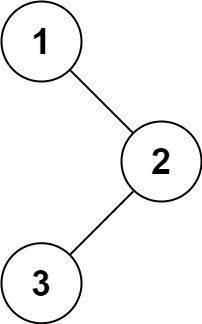LeetCode刷题—二叉树的遍历
此篇用于梳理二叉树的遍历方式:深度优先遍历(前、中、后序遍历)和广度优先遍历,不仅能快速领会思想和总结规律,还可以顺便刷下这些题:
94,二叉树的中序遍历,medium 102,二叉树的层序遍历,easy 230,二叉搜索树中第k小的元素,medium 501,二叉搜索树中的众数,easy 530,二叉树搜索树的最小绝对差,easy
一、二叉树的遍历有四种方式:
1. 前序遍历:根-左-右
2. 中序遍历:左-根-右
3. 后序遍历:左-右-根
4. 层次遍历:BFS + 分层存储
例如: 1
/ \
2 3
/ \ \
4 5 6
层次遍历使用 BFS 实现,利用的就是 BFS 一层一层遍历的特性;而前序、中序、后序遍历利用了 DFS 实现。
前序、中序、后序遍只是在对节点访问的顺序有一点不同,其它都相同。
注意:对于二叉搜索树,常进行中序遍历,其结果由小到大的顺序有时对解题很有帮助。 ## 二、二叉树遍历的模板 ##### 1. 前序遍历:根-左-右 //前序遍历
void preorderTraversal(TreeNode root){
visit(root);
preorderTraversal(root.left);
preorderTraversal(root.right);
}
//中序遍历 |
3. 后序遍历:左-右-根
//后序遍历 |
4. 层次遍历
使用【队列】来由上至下由左至右遍历,队列由 LinkedList 实现。
三、实现(递归与迭代两种方式)
1. 前序遍历:根-左-右
LeetCode的144题:二叉树的前序遍历
给你二叉树的根节点 root ,返回它节点值的 前序 遍历。
示例 1:

输入:root = [1,null,2,3] 输出:[1,2,3]
方法一:递归。
class Solution {
public List<Integer> preorderTraversal(TreeNode root) {
List<Integer> res = new ArrayList<>();
dfs(root, res);
return res;
}
public List<Integer> dfs(TreeNode root, List<Integer> res){
if(root == null) return null;
res.add(root.val);
dfs(root.left, res);
dfs(root.right, res);
return res;
}
}方法二:迭代。借助栈。
思路: 首先应该创建一个Stack用来存放节点,首先我们想要打印根节点的数据,此时Stack里面的内容为空,所以我们优先将头结点加入Stack,然后打印。
之后应该先打印左子树,然后右子树。所以先加入Stack的就是右子树,然后左子树。
代码:
class Solution {
public List<Integer> preorderTraversal(TreeNode root) {
if(root == null) return new ArrayList<>();
List<Integer> res = new ArrayList<>();
Stack<TreeNode> stack = new Stack<>();
stack.push(root);
while(!stack.isEmpty()){
TreeNode node = stack.pop();
res.add(node.val);
//栈先进后出,为保证左边的子节点先弹出,把右子节点压入栈
if(node.right != null) stack.push(node.right);
if(node.left != null) stack.push(node.left);
}
return res;
}
2. 中序遍历:左-根-右
LeetCode的94题:二叉树的中序遍历
- 方法一:递归。
class Solution {
public List<Integer> postorderTraversal(TreeNode root) {
List<Integer> res = new ArrayList<>();
dfs(root, res);
return res;
}
public void dfs(TreeNode root, List<Integer> res){
//左中右
if(root == null) return ;
dfs(root.left, res);
res.add(root.val);
dfs(root.right, res);
}
} - 方法二:迭代。
- 思路: 从根节点向左找到最后一个左子节点,并压入栈。弹出栈顶节点,并加入结果集。再找此节点的右子节点,如果为空将弹出根节点。

- 代码: ##### 3. 后序遍历:左-右-根 ###### LeetCode的145题:二叉树的后序遍历
class Solution {
public List<Integer> inorderTraversal(TreeNode root) {
if(root == null) return new ArrayList<>();
List<Integer> res = new ArrayList<>();
Stack<TreeNode> stack = new Stack<>();
while(root != null || !stack.isEmpty()){
//向左找左子节点
while(root != null){
//将左子节点入栈
stack.push(root);
root = root.left;
}
//找到左子树最后一个左子节点弹出并添加至结果集
root = stack.pop();
res.add(root.val);
//找此节点的右子节点进入上面循环
root = root.right;
}
return res;
}
}
- 思路: 从根节点向左找到最后一个左子节点,并压入栈。弹出栈顶节点,并加入结果集。再找此节点的右子节点,如果为空将弹出根节点。
- 方法一:递归。
class Solution {
public List<Integer> postorderTraversal(TreeNode root) {
List<Integer> res = new ArrayList<>();
dfs(root, res);
return res;
}
public void dfs(TreeNode root, List<Integer> res){
//左右中
if(root == null) return ;
dfs(root.left, res);
dfs(root.right, res);
res.add(root.val);
}
} - 方法二:迭代。前序遍历的结果倒序添加。 ##### 4. 层次遍历:BFS遍历 + 分层
class Solution {
public List<Integer> postorderTraversal(TreeNode root) {
if(root == null) return new ArrayList<>();
List<Integer> res = new ArrayList<>();
Stack<TreeNode> stack = new Stack<>();
if(root != null) stack.push(root);
while(!stack.isEmpty()){
TreeNode node = stack.pop();
if(node.left != null) stack.push(node.left);
if(node.right != null) stack.push(node.right);
res.add(0, node.val);
}
return res;
}
}

//BFS遍历实现 |
LeetCode的102题:二叉树的层次遍历
给你一个二叉树,请你返回其按 层序遍历 得到的节点值。 (即逐层地,从左到右访问所有节点)。
示例: 二叉树:[3,9,20,null,null,15,7],
3
/ \
9 20
/ \
15 7返回其层次遍历结果:
[ [3], [9,20], [15,7]]
- 思路:由上面BFS遍历过程,稍加修改,即将每层的节点序列存储到集合temp中,再将每一层添加至
List<List<Integer>> res即可 - 代码:
class Solution { |
四、二叉搜索树的中序遍历
由于BST树左小右大、中序遍历的结果由小到大,常利用这一结论来解题。如: ###### LeetCode的230题:二叉搜索树中第k小的元素 给定一个二叉搜索树,编写一个函数 kthSmallest 来查找其中第 k 个最小的元素。
说明: 你可以假设 k 总是有效的,1 ≤ k ≤ 二叉搜索树元素个数。
示例 1:
输入: root = [3,1,4,null,2], k = 1 |
- 思路:直接应用上面中序遍历的结果,返回 list 的 第 k - 1 个元素即可。
- 递归
class Solution {
public int kthSmallest(TreeNode root, int k) {
List<TreeNode> res = new ArrayList<>();
helper(root, res);
return res.get(k - 1).val;
}
//中序遍历结果
public void helper(TreeNode root, List<TreeNode> list){
if(root == null) return;
helper(root.left, list);
list.add(root);
helper(root.right, list);
}
} - 迭代 ###### LeetCode的501题:二叉搜索树中的众数 给定一个有相同值的二叉搜索树(BST),找出 BST 中的所有众数(出现频率最高的元素)。
class Solution {
public int kthSmallest(TreeNode root, int k) {
if(root == null) return -1;
Stack<TreeNode> stack = new Stack<>();
while(root != null || !stack.isEmpty()){
//向左找左子节点
while(root != null){
//将左子节点入栈
stack.push(root);
root = root.left;
}
//找到左子树最后一个左子节点弹出并添加至结果集
root = stack.pop();
//找到第k小的节点
k--;
if(k == 0) return root.val;
//找此节点的右子节点进入上面循环
root = root.right;
}
return -1;
}
}
- 递归
假定 BST 有如下定义:
结点左子树中所含结点的值小于等于当前结点的值 结点右子树中所含结点的值大于等于当前结点的值 左子树和右子树都是二叉搜索树
例如: 给定 BST [1,null,2,2],
1 |
返回[2].
提示:如果众数超过1个,不需考虑输出顺序 - 方法:改造中序遍历。
思路:
加入全局变量当前节点值
curVal,当前节点出现次数count,最大出现的次数maxCount- 如果当前节点值
root.val == curVal,count++ - 如果不等于
curVal,说明遇到下一个新的值,更新curVal = root.val,且count = 1
比较
count与 maxCount- 如果相等,添加到结果集中
- 如果
count > maxCount,清空结果集,并把节点值root.val加入结果集,更新maxCount = count###### LeetCode的530题:二叉树搜索树的最小绝对差 给你一棵所有节点为非负值的二叉搜索树,请你计算树中任意两节点的差的绝对值的最小值。class Solution {
int curVal;//当前节点的值
int count;//cur节点的次数
int maxCount;//当前的最大次数
List<Integer> res = new ArrayList<>();
public int[] findMode(TreeNode root) {
inorder(root);
int[] ans = new int[res.size()];
for(int i = 0; i < res.size(); i++){
ans[i] = res.get(i);
}
return ans;
}
public void inorder(TreeNode root){
if(root == null) return;
inorder(root.left);
//如果当前节点值 node.val = cur,count + 1
int rootVal = root.val;
if(rootVal == curVal){
count++;
}
// 如果不等于cur,说明遇到下一个新的值,更新cur,且count = 1
else{
curVal = rootVal;
count = 1;
}
//比较count 与 maxCount
// 如果相等,添加到结果集中
if(count == maxCount){
res.add(rootVal);
}
// 如果count > maxCount,清空结果集,并把节点值 node.val 加入结果集,更新maxCount = count
else if(count > maxCount){
res.clear();
res.add(rootVal);
maxCount = count;
}
inorder(root.right);
}
}
- 如果当前节点值
示例: 输入:
1 |
输出: 1
解释: 最小绝对差为 1,其中 2 和 1 的差的绝对值为 1(或者 2 和 3)。 - 方法:改造中序遍历。因为二叉搜索树的中序遍历结果是升序的,我们只需要在中序遍历的时候和前一个节点比较,保存最小的差值即可。建立前一个节点作为全局变量。
- 递归:
class Solution {
TreeNode pre;//前一个节点
int min = Integer.MAX_VALUE;
public int getMinimumDifference(TreeNode root) {
inorder(root);
return min;
}
public void inorder(TreeNode root){
if(root == null) return;
inorder(root.left);
if(pre != null)
min = Math.min(min, root.val - pre.val);
pre = root;//更新pre到下个节点
inorder(root.right);
}
} - 迭代
public int getMinimumDifference(TreeNode root) {
int min = Integer.MAX_VALUE;
Stack<TreeNode> stack = new Stack<>();
TreeNode cur = root, prev = null;
while (cur != null || !stack.empty()) {
if (cur != null) {
stack.push(cur);
cur = cur.left;
} else {
cur = stack.pop();
//在这里进行改造
if (prev != null)
min = Math.min(min, cur.val - prev.val);
prev = cur;
cur = cur.right;
}
}
return min;
}